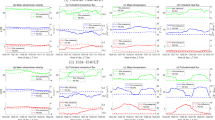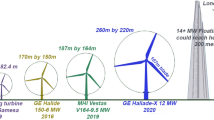Abstract
Based on one year gradient wind data and the wind data of a strong typhoon observed by three meteorological towers located on the coast and at the inshore sea, the underlying surfaces of the meteorological towers were classified and the roughness lengths were calculated quantitatively. On the basis of strong wind characteristic representative assessment and sample selection on the wind data of strong typhoon Hagupit, the gust factor variation characteristics of tropical cyclones under different underlying surfaces were analyzed. The observed fact and variation rule were found as follows: 1) The roughness lengths under neutral atmospheric condition which were calculated using logarithmic wind profile fitting based on the observation data can describe the slight change of the underlying surface objectively. 2) The gust factor of strong typhoon wind didn’t have variation trends with wind speed. But the variation amplitude of the gust factor was rather large over rough underlying surface which had pronounced effect on the numerical design of structural engineering. 3) The variation of the gust factor with height satisfied power law or logarithmic law. The power law fitting was more suitable for smooth underlying surface while the logarithmic fitting was better over rough underlying surface. 4) The observation data also suggested that the relationship between gust factor and roughness length can be described by power or linear equation. 5) The gust factor observed in this typhoon case was different from the gust factor recommended by WMO: The gust factor of the offshore wind came from rough underlying surface was higher than the value recommended by WMO while the gust factor of the onshore wind came from smooth underlying surface is less than the WMO recommended value.
Similar content being viewed by others
References
Xiang H F. Environment, disaster and mechanics. Mech Eng, 1991, 13: 1–6
Xiang H F. State of the art and prospect in studies on structural wind engineering. J Vibration Eng, 1997, 10: 258–263
Ministry of Construction of People’s Republic of China. Load Code for the Design of Building Structures (GB50009-2001). Beijing: China Architecture & Building Press, 2002. 47–48
Song L L, Mao H Q, Zhi S Q. Analysis on boundary layer turbulent features of landfalling typhoon. Acta Meteor Sinica, 2005, 63: 915–921
Song L L, Pang J B, Jiang C L, et al. Field measurement and analysis of turbulence coherence for typhoon Nuri at Macao Friendship Bridge. Sci China Tech Sci, 2010, 53: 2647–2657
Naess A, Clausen P H, Sandvik R. Gust factors for locations downstream of steep mountain ridge. J Wind Eng Ind Aerodyn, 2000, 87: 131–146
Powell M D, Vickery P J, Reinhold T A. Reduced drag coefficients for high wind speeds in tropical cyclones. Nature, 2003, 422: 279–283
Wang H, Li A Q, Guo T, et al. Field measurement on wind characteristic and buffeting response of the Runyang Suspension Bridge during typhoon Matsa. Sci China Ser E-Tech Sci, 2009, 52: 1354–1362
Schroeder J L, Simth D A. Hurricane bonnie wind flow characteristics as determined from WEMITE. J Wind Eng Ind Aerodyn, 2003, 91: 767–789
Cao S Y, Tamura Y, Kikuchi N, et al. Wind characteristics of a strong typhoon. J Wind Eng Ind Aerodyn, 2009, 97: 11–21
Powell M D, Bowman D, Gilhousen D, et al. Torpical cycone winds at landfall. Amer Meteor Soc, 2004, 6: 845–851
Harper B A, Kepert J D, Ginger J D. Guidelines for converting between various wind averaging periods in tropical cyclone conditions. In: Sixth Tropical Cyclone RSMCs/TCWCs Technical Coordination Meeting Technical Document, Brisbane, 2009
China Meteorological Administration. Specification of Surface Meteorology. Beijing: China Meteorological Press, 2003. 108–116
Chen R S. Typhoon (in Chinese). Fujian: Fujian Science & Technology Press, 2002
Stull R B. An Introduction to Boundary Layer Meteorology. Qindao: Press of Ocean University of Qindao, 1991. 402–403
Hu Z B, Yu B F. Review on methods calculating aerodynamic parameters over urban underlying surface. J Meteor Environ, 2008, 24: 55–60
Liu X P, Dong J B. Review of aerodynamic roughness length. J Des Res, 2003, 23: 337–346
Simiu E, Scanlan R H. Wind effects on structures: An introduction to wind engineering. Version 2. Shanghai: Tongji University Press, 1992. 27–29
Gu M, kuang J, Quan Y, et al. Analysis of measured wind speed data on top of SWFC. J Vib Shock, 2009, 28: 114–118, 122
Zhi L H, Li Q S, Hu F. Field measurements of strong wind characteristics near ground in urban area. J Hunan Univ (Nat Sci), 2009, 36: 8–12
Shi W H, Li Z N, Zhang C H. Field measurements of strong wind characteristics near ground in Wenzhou district. J Build Struc, 2010, 31: 34–40
Wang B L, Hu F, Cheng X L. Wind gust and turbulence statistics of typhoon in south China. Acta Meteor Sinica, 2010, 1: 113–127
Author information
Authors and Affiliations
Corresponding author
Rights and permissions
About this article
Cite this article
Chen, W., Song, L., Zhi, S. et al. Analysis on gust factor of tropical cyclone strong wind over different underlying surfaces. Sci. China Technol. Sci. 54, 2576–2586 (2011). https://doi.org/10.1007/s11431-011-4511-0
Received:
Accepted:
Published:
Issue Date:
DOI: https://doi.org/10.1007/s11431-011-4511-0




